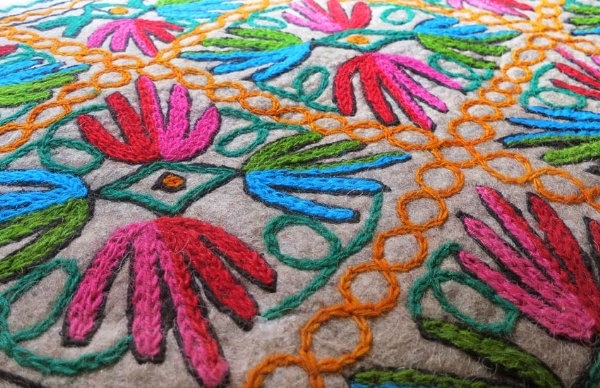PM Modi applauds revival of Namda craft: What's this Kashmir's centuries-old rich HERITAGE?
18 Jul 2023 12:32:24
Recently, Prime Minister Narendra Modi, through his tweet described the revival story of Kashmir's centuries-old 'Namda' craft. Let's explore what this historic craft is? The craft of 'Namda' is indeed a centuries-old traditional art form that originated in the region of Kashmir, which is located in the northern part of the Indian subcontinent. Namda is a type of felted wool rug or mat that is handmade using a unique process.

The word "Namda" is derived from the Persian language, where "Nam" means wool and "da" means rug. The craft of Namda involves felting or matting wool fibers together to create a dense and sturdy fabric. This fabric is then used to make various items such as rugs, mats, cushions, and even wall hangings. The craft of Namda has its origins in the region of Kashmir, which is known for its rich cultural heritage and artistic traditions. The exact origins of the craft are not well-documented, but it is believed to have been practiced in the region for several centuries.
Kashmir has a long history of wool production, as the region is home to a breed of sheep known as Ladakhi sheep, which produce fine wool suitable for felting. The availability of wool and the need for warm and durable textiles in the region likely contributed to the development of the Namda craft. The craft may have been influenced by the Central Asian and Persian cultures, as Kashmir has historical connections and trade routes with these regions. The word "Namda" itself is derived from the Persian language, indicating possible cultural influences.
Over time, the craft of Namda evolved and developed its unique techniques and designs, influenced by the local culture and craftsmanship. The artisans in Kashmir honed their skills and passed down their knowledge from one generation to another, preserving and refining the craft. Namda craft was traditionally practiced in homes and small workshops in Kashmir. It was an important cottage industry, with artisans working on their individual pieces or collaborating with other craftsmen to create larger rugs or decorative items. The craft provided employment and livelihood opportunities to many artisans in the region.
What is the craft?
The process of making Namda starts with shearing wool from sheep, typically from the Ladakhi breed, which produces fine and soft wool. The wool is then washed, cleaned, and dyed using natural dyes to achieve vibrant colors. The dyed wool is spread evenly on a flat surface, and the craftsmen begin the felting process. The wool fibers are aligned and layered in a crisscross pattern, and then hot water mixed with soap or detergent is poured over them. The wool is then beaten and pressed by hand or using a wooden tool known as a patee or thapi. This repetitive action causes the wool fibers to entangle and interlock, creating a solid fabric. The process continues until the desired thickness and strength are achieved.
Once the fabric is formed, it is left to dry in the sun. After drying, the Namda is further embellished with intricate embroidery, often done by skilled craftsmen using vibrant threads and traditional patterns. The embroidery enhances the beauty of the Namda and adds a decorative element to the final product.
Generational Art
Namda craft has been passed down through generations in Kashmir and is an integral part of the region's cultural heritage. It requires great skill, patience, and attention to detail to create these beautiful and durable woolen products. The finished Namdas are not only functional but also highly valued as works of art, reflecting the rich cultural traditions of Kashmir.
Over the years, the Namda craft has faced challenges due to changing market trends and competition from machine-made products. However, efforts have been made to preserve and promote this traditional craft. Organizations, artisans, and the government have taken initiatives to provide training, design innovation, and marketing support to the craftsmen, ensuring the survival and growth of the Namda craft.
Today, Namda products from Kashmir are appreciated and sought after worldwide for their unique beauty, craftsmanship, and cultural significance. They serve as a testament to the rich artistic heritage of the region and continue to be cherished as valuable artistic and functional pieces.
Namda's export market
Namda rugs from Kashmir have gained popularity and are exported to various parts of the world. The export market for Namda rugs allows artisans to showcase their craftsmanship and traditional skills to a global audience. However, it's important to note that specific data on the export of Namda rugs from Kashmir may not be readily available, as it depends on factors such as market demand, trade regulations, and individual artisan initiatives. Nevertheless, Kashmiri crafts, including Namda rugs, have a reputation for their quality and uniqueness, making them attractive to international buyers.
The export of Namda rugs is typically facilitated through various channels, including direct sales to international buyers, participation in trade fairs and exhibitions, and collaborations with export companies or organizations specializing in handcrafted products. These channels help connect Kashmiri artisans with potential buyers and expand the market reach of Namda rugs.
To promote exports, the government of India, through organizations such as the Export Promotion Council for Handicrafts (EPCH) and the Jammu and Kashmir Handicrafts Department, provides support to artisans and exporters. They offer training, financial assistance, marketing guidance, and opportunities to showcase and sell their products in international markets.
Exported Namda rugs contribute to the economic development of the artisans and the overall craft sector in Kashmir. They also help in creating awareness and appreciation for the traditional crafts of the region on a global scale. The international market provides exposure and opportunities for artisans to diversify their designs, incorporate modern aesthetics, and cater to different customer preferences.
--
